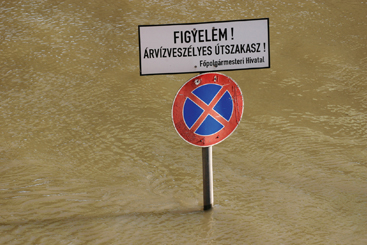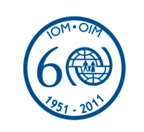Migration, climate change adaptation and disaster risk reduction
A new game puts the Danube Basin and its natural and cultural treasures in the
spotlight and gives players the incentive to spend time exploring the river – proving
that learning doesn’t have to be boring.

Migration, climate change adaptation and disaster risk reduction
Understanding the link between disasters and human displacement can help develop relevant policies for international cooperation in the wake of climate-induced changes in the future.

Signs such as this one, reading "Warning! Flood risk area!", point to the dire necessity for long-term strategies to reconcile economic goals with environmental security and provide vulnerable citizens with durable solutions.
The environmental crises, both man-made and natural, that are becoming characteristic of the 21st century are push factors contributing to forced mobility or displacement. For portions of the Danube River Region, these crises have included the experience or threat of flooding, drought, pollution of groundwater, and wetland depletion over the last decade, events which can lead to long-term problems of food insecurity or other livelihood effects. Because these problems are a regional concern as much as a local one, the affected countries have an interest to create mutually beneficial, cross-border water and environmental management policies to ensure durable solutions and reduce the impact of slow-onset and sudden disasters on at-risk communities.
Environmental Migration. An official definition of environmental migrants currently does not exist, though the International Organisation for Migration (IOM) has developed a working definition. Environmental migrants are "persons or groups of persons who, for reasons of sudden or progressive changes in the environment that adversely affect their lives or living conditions, are obliged to leave their habitual homes, or choose to do so, either temporarily or permanently and who move either within their territory or abroad". Environmental shifts in the 21st century are making these populations a key feature of policy debates and climate change conferences.
Proactive policies that can reduce the scope and impact of disasters on vulnerable populations are known as disaster risk reduction (DRR) strategies. The Hyogo Framework, formulated by an international coalition in 2005, outlines key disaster reduction policy goals for 2005–2015, emphasising prevention, mitigation, resilience, preparedness and vulnerability reduction, while taking gender, age and cultural diversity into account. The other option is to enhance Climate Change Adaptation (CCA), which is broadly defined as a set of actions "to reduce the impacts of climate change that are happening now and increase resilience to future impacts". It encompasses a variety of activities, including education and training, as well as more technical measures, such as increasing coastal protection and distributing drought-resistant seeds.
Regarding the Danube. The Danube River is the most international river in the world, so DRR and CCA policies will require an international agenda to ensure effectiveness since any negative developments in the river will undoubtedly strain other countries in the region. This area has already experienced temporary environmentally induced migration due to flooding, the effects of which can be mitigated through wetland protection and early-warning systems. Flooding and pollution are particularly salient issues here which will ultimately affect the poorest citizens, who live primarily downstream. Because those who are most vulnerable often cannot migrate, it is increasingly important to create DRR policies to help all those potentially affected by disasters and to ensure livelihood support for those without the means to move.
Other issues affecting this area, such as pollution, wetland and groundwater depletion due to the intensification of industrial and agricultural output, require long-term strategies to reconcile economic goals with environmental security and provide vulnerable citizens with durable solutions. However, because these issues are slow-onset and are not as visible as disasters, they are not usually priorities in governmental strategies. Their significance will nevertheless increase if actions are not taken to reduce their impact.
Methods of response. The IOM was among the first organisations to explore the link between disasters and human displacement as a human adaptation strategy. Based on its mandate, it has the responsibility to raise awareness of the potential impact of disasters on human mobility and the need to factor this into global, regional, national and local DRR, CCA and development strategies. The IOM has gained experience employing DRR and disaster impact management strategies around the world, through: furnishing technical assistance for flood-prone areas; developing regional preparedness strategies and cross-border mobility in drought areas; creating temporary and circular migration schemes; constructing transitional shelters; and providing primary health care to victims in regions struck by disaster. While these responses cannot (nor should they) be repeated identically in the Danube River Region, there is enough evidence portending the growing significance of these issues in future, making the development of similar DRR strategies a practical and necessary step to ensure emergency preparedness.
The Serbian government is already a proactive proponent of DRR strategies. In October 2010, it held a National Policy Dialogue on Disaster Risk Reduction in cooperation with the United Nations Development Program (UNDP), the World Meteorological Organisation (WMO) and national partners. The two-day dialogue ended with official endorsement of recommendations for future action to strengthen Serbia's DRR system. As a country located in the Danube Region, this sets an important precedent for action in neighboring states, and contributes to the dissemination of good practices in a cooperative regional dialogue.
Environmental migration and disaster risk reduction are mitigated by policies taking international development, poverty reduction and good governance into account. For the benefit of all the nations of the Danube River Region, they should follow the example of Serbia and use the expertise and experience of the IOM to develop relevant policies for international cooperation in the wake of disasters and climate-induced changes in the future.
This article was prepared by the International Organization for Migration (IOM). The IOM was founded in 1951, and is the the leading inter-governmental organization in the field of migration and works closely with governmental, intergovernmental and non-governmental partners.







